Drinking deep from the well of sadness
Exploring the Ocean Madness tracker in Deep Regrets, an "unfortunate fishing game about pulling progressively more horrifying things out of the ocean."
Last week we explored the concept of board game SRDs, triggering a significant amount of discussion! As always, Skeleton Code Machine readers expressed themselves in a kind and informative manner, really giving me some things to think about. My opinion on the subject has been changed enough that I might either update the original article or post a follow-up!1 Thank you to everyone who commented!
This week we are looking at the Ocean Madness tracker in Deep Regrets, a board game of deep sea fishing with a touch of cosmic horror.2
Deep Regrets
Deep Regrets (Cowan, 2025) is “an unfortunate fishing game about pulling progressively more horrifying things out of the ocean.” Filled with amazing art by Judson Cowan (the designer), it claims to be “the most unsettling fishing board game ever created.”
The core game loop is relatively simple with gameplay focused on fishing:
Reveal fish: Reveal the card from your current depth (I, II, or III), resolve any card effects, and attempt to catch it.
Spend dice to catch it: Catching fish requires spending pre-rolled dice equal to or greater than their catch value (i.e. difficulty). Bigger fish and harder to catch fish are worth more.
In addition, players can stay at sea and fish or return to port to sell fish and purchase equipment — rods, reels, and supplies. Spending more coin means drawing more cards and keeping more (e.g. spend $5 to draw five and keep two). Fish can be mounted for end game points or eaten to unlock special abilities.
Players take actions until everyone passes, ending the day. Play continues through a work week of Monday through Saturday and then ends.3
Fair & foul fish
Not all fish are the same though. Some are fair (e.g. frilled shark) and some are foul (e.g. psychic interloper). Selling a foul fish causes you to gain a regret — a shameful act from your life.
Mechanically, regrets are cards that have a value and a bit of flavor text on them:
“Summoned an ancient evil.” (3)
“Drank too deep from the well of sadness.” (2)
“Gazed too long into the abyss.” (2)
“Over-salted my breakfast.” (0)
In general, regrets are bad. For example, the player with the highest total regret value loses one mounted fish at the end of the game. But not always.
As your regrets mount…
While a player’s total regret value is hidden, the total number of regret cards is open information. The number of regret cards is recorded on the Ocean Madness tracker with a cube for each player. Gain another regret card and your cube moves one more level down. Discard a regret card, and you move one level back up the tracker.
A bit like the Sanity Track in Cthulhu: Death May Die (Daviau & Lang, 2019), pushing your luck is a good strategy. Increasing on the track unlocks new abilities and/or other advantages.
In Deep Regrets, the Ocean Madness tracker position changes two key things:
Fair & Foul Fish Values: As a player accumulates regrets it changes the market value for selling fish. With zero regrets, Fair Fish are most valuable with a +2 modifier and Foul Fish are least valuable with -2 modifier. As regrets mount, however, the Foul Fish become increasingly attractive (+2) and the Fair Fish become unattractive (-2).
Maximum Dice: Gaining regrets increases the maximum number of dice a player can have, starting at 4. Dice are important because they are “spent” to catch fish. Every three or so additional regrets increases the maximum, up to 8 dice.
This is interesting because fish that might be valuable at the start of the game become less valuable as your madness increases. It’s almost like switching allegiance in a game of influence vs. control.
Do you try to discard regrets as you get them, limiting your dice but eliminating risk of discarding your highest value mounted fish at the end? Or do you embrace the madness, gaining more dice, knowing that it will cost you in the end?
Music in its roar
Originally published in Dead Horse Magazine, Music in its Roar is a one-page, horror, micro-TTRPG I wrote, inspired by The Shadow over Innsmouth by H.P. Lovecraft:
“You just haven’t been yourself since the fishing trip. Now, the faint but endless chant of the ocean calls you back.”
It’s a fun little experiment using a hex flower game engine (HFGE) — rolling 2d6 and moving a token to track your fishy transformation.4 I’d love, however, to expand the general concept into a full-sized game. It’s something that’s been sitting half-written in my notes for quite some time!
One of the ideas in this untitled game was similar to that of the Ocean Madness tracker in Deep Regrets, but with your transformation into an aquatic creature instead of madness. At the start of the game, some of the town’s factions are more favorable and easier to woo. As your eyes bulge and skin becomes slick, however, those factions view you less favorably… while others begin to worship you.
The tracker doesn’t range from “good” to “bad” but rather is a tool. Which end of the tracker you want to be on depends on the goal you want to accomplish.
I usually post about game development at Exeunt Omnes, but wanted to share!
Love reading Skeleton Code Machine for free each week?
Help support it with a Tumulus subscription or purchase from the Exeunt Press Shop!
Conclusion
Some things to think about:
Game art matters: While I didn’t discuss it too much, the art in Deep Regrets is fantastic — dark and humorous. The designer/artist nailed the style, color palette, and just everything about the design. While The Dice Tower review didn’t love the randomness of the game, they all said they had fun with it. The main driver was the art and the witty text.
Trackers with no bad end: Many trackers (i.e. linear tracking methods) in board games have a good end and a bad end. You start low and want to go high, or something similar. An opportunity exists to make trackers where both ends are good, and it is an exercise in player agency that decides which is best.
Adding narrative elements: While Deep Regrets is a board game, there was an interesting note in the rulebook (p. 19): “Each Regret card has a unique Regret on it. At the end of the game, feel free to craft a narrative that ties all of your Regrets together and force the other players to listen to your miserable tale of woe.”
What do you think? Where would your cube be on the Ocean Madness tracker?
— E.P. 💀
P.S. Get ADVENTURE! Make Your Own TTRPG Adventure, the latest guide from Skeleton Code Machine, now at the Exeunt Press Shop! 🧙
Skeleton Code Machine is a production of Exeunt Press. All previous posts are in the Archive on the web. Subscribe to TUMULUS to get more design inspiration. If you want to see what else is happening at Exeunt Press, check out the Exeunt Omnes newsletter.
Part of the complexity is that the term SRD can mean “an attempt to control mechanisms with a license when they can’t be copyrighted” but it can also mean “a designer’s notes and creation kit to help others make cool stuff.” Those are two very different things, so any discussion that is reduced to “SRD good” or “SRD bad” runs the risk of becoming messy.
I am incapable of reading “ocean madness” without mentally saying it as SPACE MADNESS.
As always, this is not a complete explanation of how to play the game. I don’t write game reviews at Skeleton Code Machine, but rather prefer to zoom in one of specific mechanism of a game and explore what makes it interesting.
You can read more about hex flower game engines (with an example) in Tumulus 1: Do not trust robots. which is available as a back issue. For upcoming issues, I recommend subscribing for a significant discount!

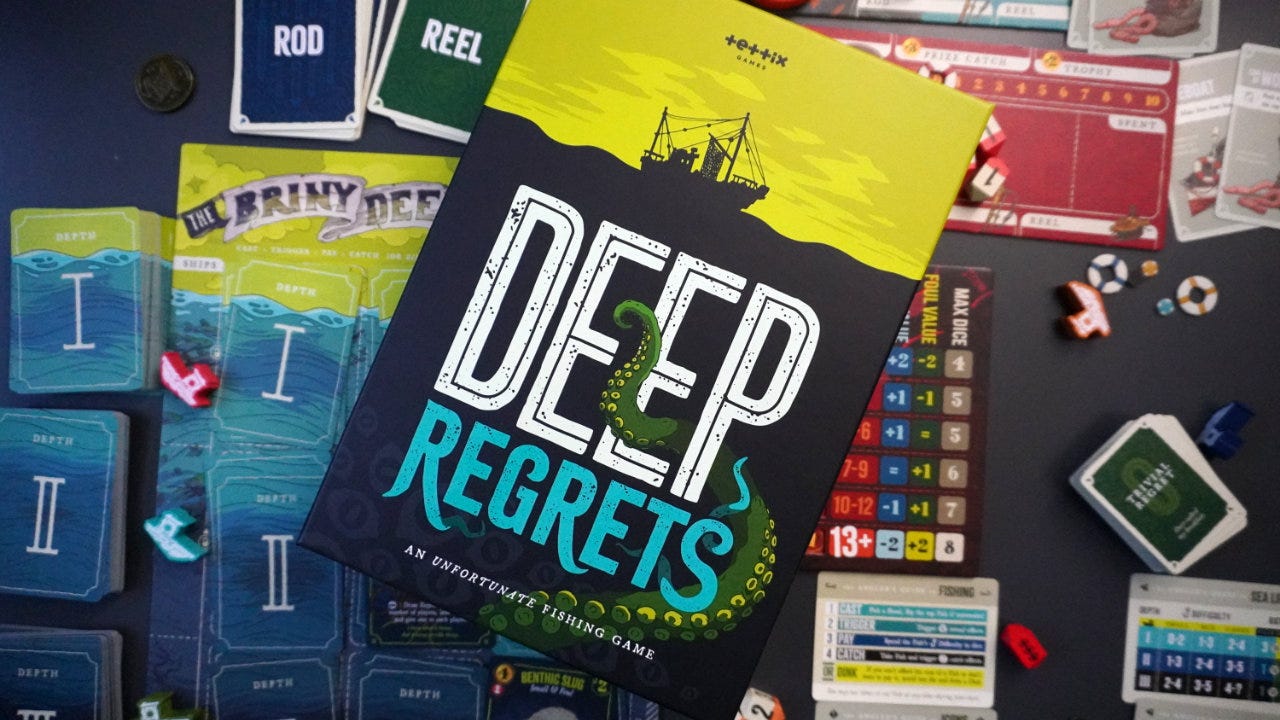
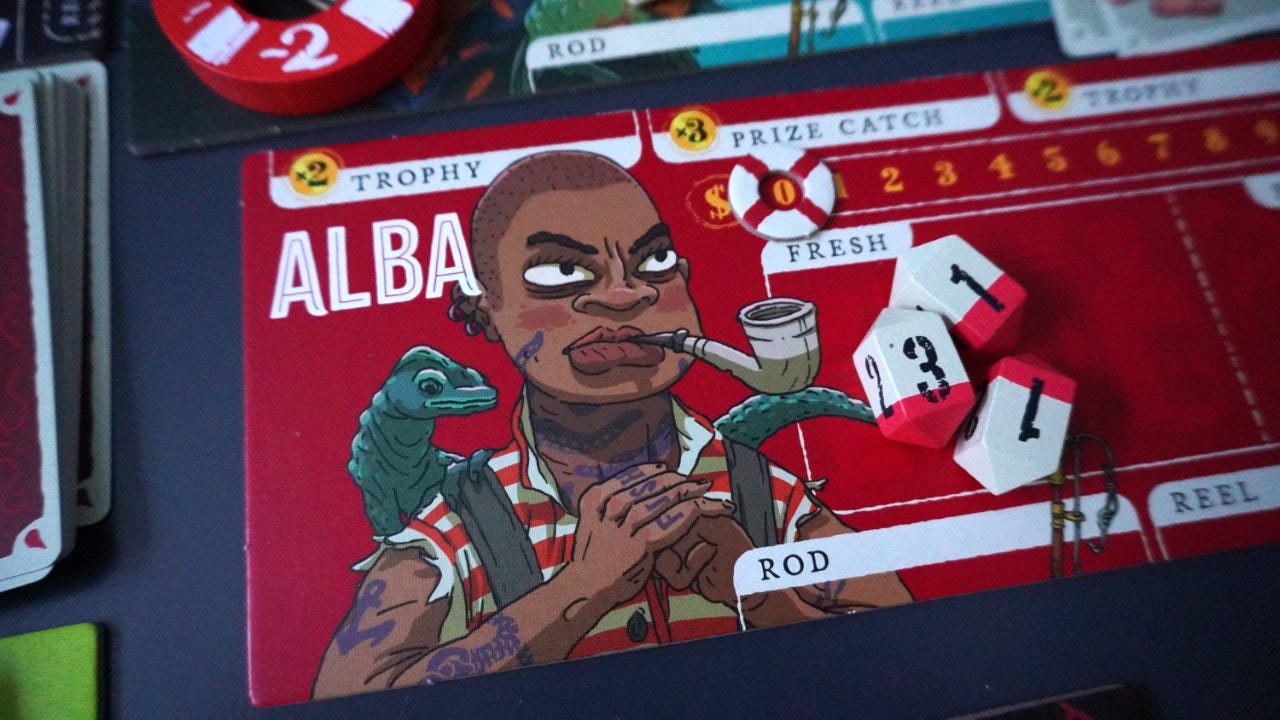

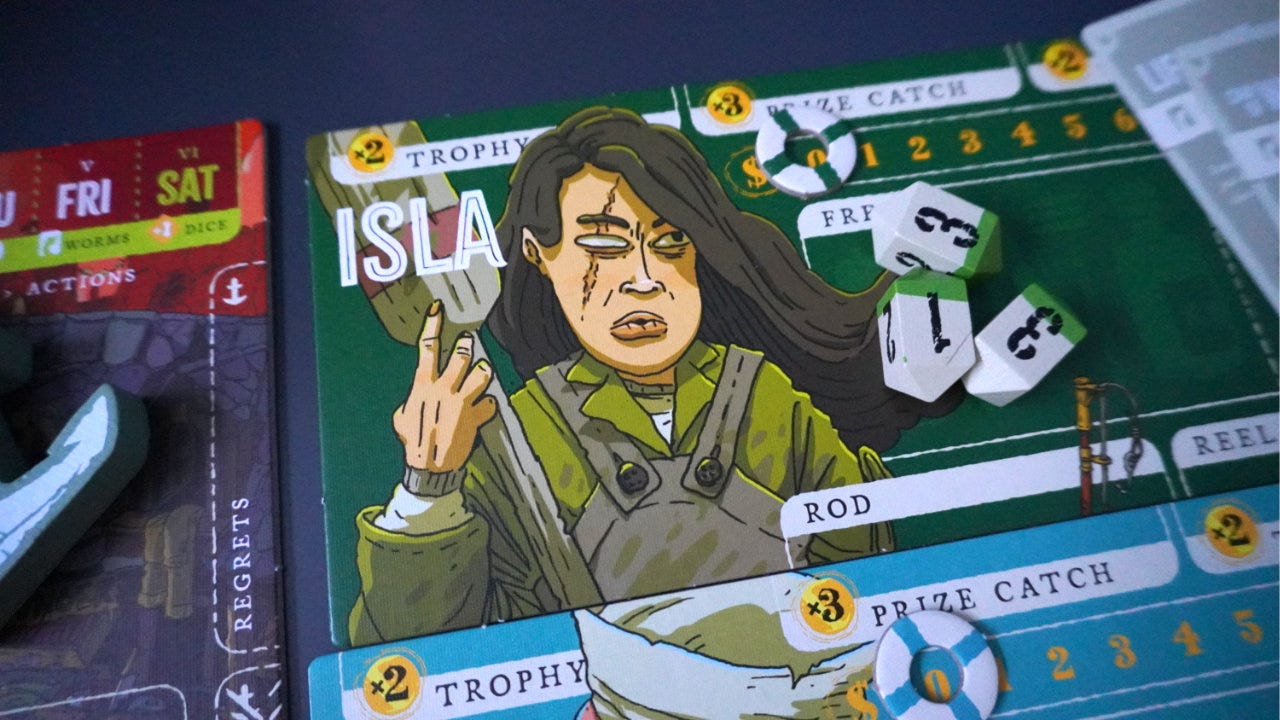

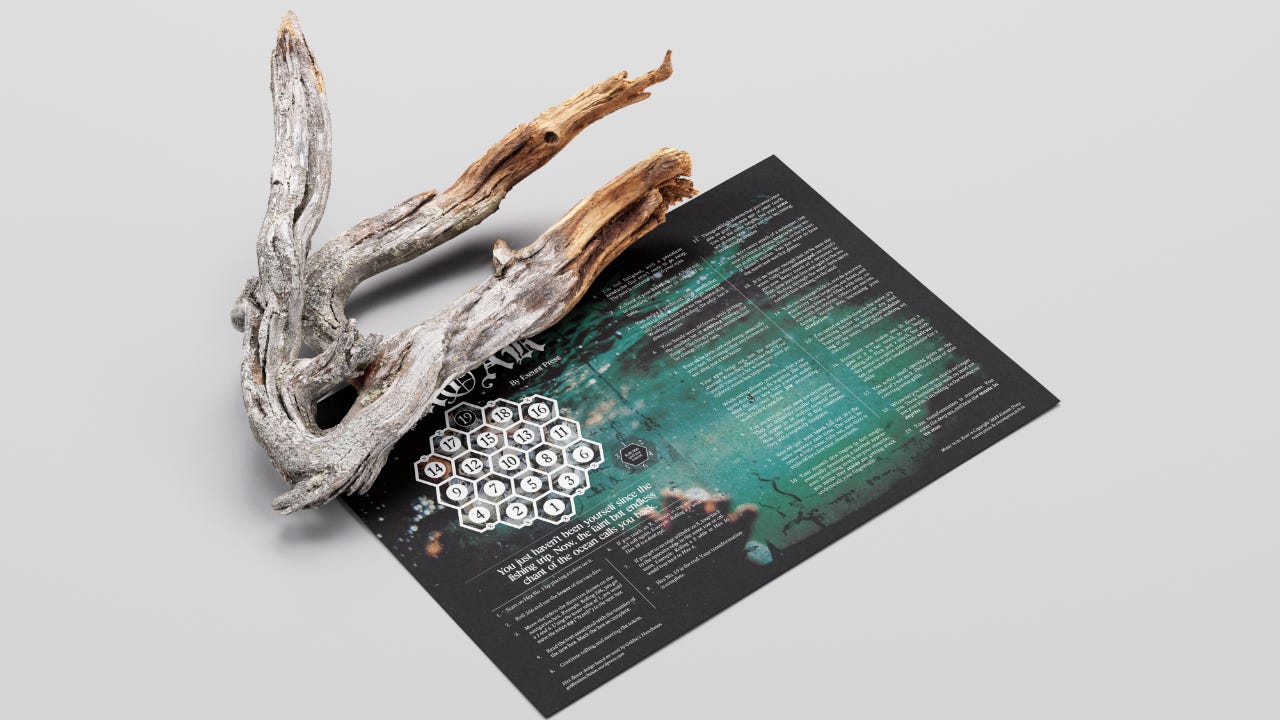
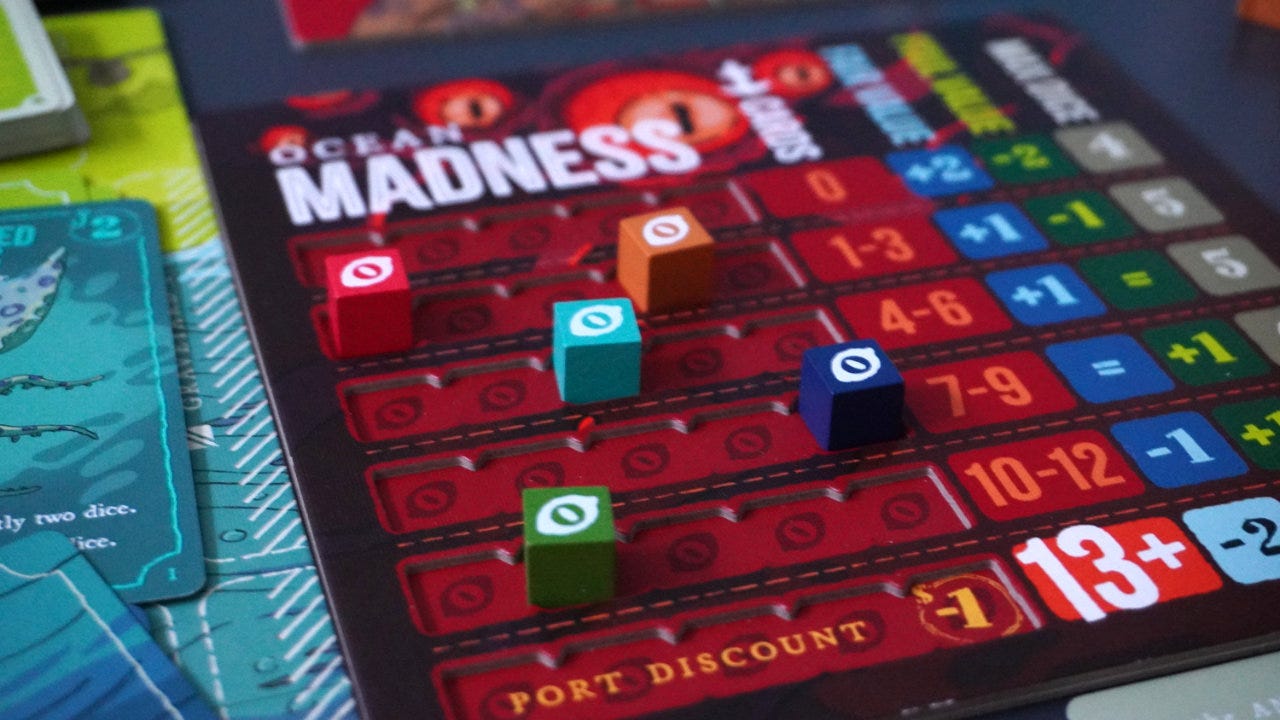
I feel someone should say the word “Dredge” at least once under this review.
The art is amazing, and there’s so much of it! If the designer hadn’t also done all the art, there’s no way it would be affordable, it must have taken hundreds of hours work.
It made me remember what Kickstarter was originally set up for - crazy, wonderful passion projects that wouldn’t have got off the ground otherwise
The card backs which give a clue about the size of the fish lurking in the depths is a simple but brilliant mechanic too - I’ve never seen it done before